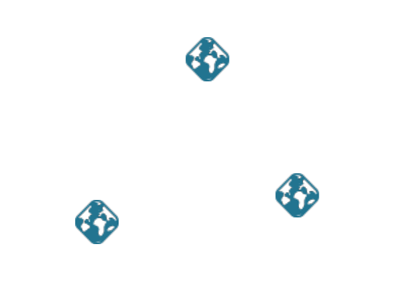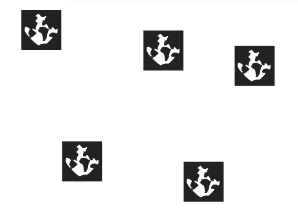Point symbolizer¶
The point symbolizer is used to style point features or centroids of non-point features.
Syntax¶
The full syntax of a point symbolizer is:
symbolizers:
- point:
symbols:
- external:
url: <text>
format: <text>
- mark:
shape: <shape>
fill-color: <color>
fill-opacity: <expression>
fill-graphic:
<graphic_options>
stroke-color: <color>
stroke-width: <expression>
stroke-opacity: <expression>
stroke-linejoin: <expression>
stroke-linecap: <expression>
stroke-dasharray: <float list>
stroke-dashoffset: <expression>
stroke-graphic:
<graphic_options>
stroke-graphic-fill:
<graphic_options>
size: <expression>
anchor: <tuple>
displacement: <tuple>
opacity: <expression>
rotation: <expression>
geometry: <expression>
uom: <text>
x-labelObstacle: <boolean>
x-composite-base: <boolean>
x-composite: <text>
where:
| Property | Required? | Description | Default value |
|---|---|---|---|
stroke-color |
No | Color of line features. | '#000000' (black) |
stroke-width |
No | Width of line features, measured in pixels. | 1 |
stroke-opacity |
No | Opacity of line features. Valid values are a decimal value between 0 (completely transparent) and 1 (completely opaque). |
1 |
stroke-linejoin |
No | How line segments are joined together. Options are mitre (sharp corner), round (round corner), and bevel (diagonal corner). |
mitre |
stroke-linecap |
No | How line features are rendered at their ends. Options are butt (sharp square edge), round (rounded edge), and square (slightly elongated square edge). |
butt |
stroke-dasharray |
No | A numeric list signifying length of lines and gaps, creating a dashed effect. Units are pixels, so "2 3" would be a repeating pattern of 2 pixels of drawn line followed by 3 pixels of blank space. If only one number is supplied, this will mean equal amounts of line and gap. |
No dash |
stroke-dashoffset |
No | Number of pixels into the dasharray to offset the drawing of the dash, used to shift the location of the lines and gaps in a dash. | 0 |
stroke-graphic |
No | A design or pattern to be used along the stroke. Output will always be a linear repeating pattern, and as such is not tied to the value of stroke-width. Can either be a mark consisting of a common shape or a URL that points to a graphic. The <graphic_options> should consist of a mapping containing symbols: followed by an external: or mark:, with appropriate parameters as detailed in the Point symbolizer section. Cannot be used with stroke-graphic-fill. |
N/A |
stroke-graphic-fill |
No | A design or pattern to be used for the fill of the stroke. The area that is to be filled is tied directly to the value of stroke-width. Can either be a mark consisting of a common shape or a URL that points to a graphic. The <graphic_options> should consist of a mapping containing symbols: followed by an external: or mark:, with appropriate parameters as detailed in the Point symbolizer section. Cannot be used with stroke-graphic. |
N/A |
| Property | Required? | Description | Default value |
|---|---|---|---|
fill-color |
No | Color of inside of features. | '#808080' (gray) |
fill-opacity |
No | Opacity of the fill. Valid values are a decimal value between 0 (completely transparent) and 1 (completely opaque). |
1 |
fill-graphic |
No | A design or pattern to be used for the fill of the feature. Can either be a mark consisting of a common shape or a URL that points to a graphic. The <graphic_options> should consist of a mapping containing symbols: followed by an external: or mark:, with appropriate parameters as detailed in the Point symbolizer section. |
None |
The use of fill-graphic allows for the following extra options:
| Property | Required? | Description | Default value |
|---|---|---|---|
x-graphic-margin |
No | Used to specify margins (in pixels) around the graphic used in the fill. Possible values are a list of four (top, right, bottom, left), a list of three (top, right and left, bottom), a list of two (top and bottom, right and left), or a single value. |
N/A |
x-random |
No | Activates random distribution of symbols. Possible values are free or grid. free generates a completely random distribution, and grid will generate a regular grid of positions, and only randomize the position of the symbol around the cell centers, providing a more even distribution. |
N/A |
x-random-tile-size |
No | When used with x-random, determines the size of the grid (in pixels) that will contain the randomly distributed symbols. |
256 |
x-random-rotation |
No | When used with x-random, activates random symbol rotation. Possible values are none or free. |
none |
x-random-symbol-count |
No | When used tih x-random, determines the number of symbols drawn. Increasing this number will generate a more dense distribution of symbols |
16 |
x-random-seed |
No | Determines the “seed” used to generate the random distribution. Changing this value will result in a different symbol distribution. | 0 |
| Property | Required? | Description | Default value |
|---|---|---|---|
external |
No | Specifies an image to use to style the point. | N/A |
url |
Yes | Location of the image. Can either be an actual URL or a file path (relative to where the style file is saved in the GeoServer data directory). Should be enclosed in single quotes. | N/A |
format |
Yes | Format of the image. Must be a valid MIME type (such as image/png for PNG, image/jpeg for JPG, image/svg+xml for SVG) |
N/A |
mark |
No | Specifies a regular shape to use to style the point. | N/A |
shape |
No | Shape of the mark. Options are square, circle, triangle, cross, x, and star. |
square |
size |
No | Size of the mark in pixels. If the aspect ratio of the mark is not 1:1 (square), will apply to the height of the graphic only, with the width scaled proportionally. | 16 |
anchor |
No | Specify the center of the symbol relative to the feature location. Value is an [x,y] tuple with decimal values from 0-1, with [0,0] meaning that the symbol is anchored to the top left, and [1,1] meaning anchored to bottom right. |
[0.5,0.5] |
displacement |
No | Specifies a distance to which to move the symbol relative to the feature. Value is an [x,y] tuple with values expressed in pixels, so [10,5] will displace the symbol 10 pixels to the right and 5 pixels down. |
[0,0] |
opacity |
No | Specifies the level of transparency. Value of 0 means entirely transparent, while 1 means entirely opaque. Only affects graphics referenced by the external parameter; the opacity of mark symbols is controled by the fill-opacity and stroke-opacity of the mark. |
1 |
rotation |
No | Value (in degrees) or rotation of the mark. Larger values increase counter-clockwise rotation. A value of 180 will make the mark upside-down. |
0 |
| Property | Required? | Description | Default value |
|---|---|---|---|
geometry |
No | Specifies which attribute to use as the geometry. | First geometry attribute found (usually named geom or the_geom) |
uom |
No | Unit of measure used for width calculations | pixel |
The following properties are equivalent to SLD “vendor options”.
| Property | Required? | Description | Default value |
|---|---|---|---|
x-labelObstacle |
No | Marks the symbolizer as an obstacle such that labels drawn via a text symbolizer will not be drawn over top of these features. Options are true or false. Note that the bounding boxes of features are used when calculating obstacles, so unintended effects may occur when marking a line or polygon symbolizer as an obstacle. |
false |
| Property | Required? | Description | Default value |
|---|---|---|---|
x-composite |
No | Allows for both alpha compositing and color blending options between symbolizers. | N/A |
x-composite-base |
No | Allows the rendering engine to use the symbolizer mapping to define a “base” buffer for subsequent compositing and blending using x-composite. See the section on Feature Styles for more details. |
false |
Examples¶
Basic point¶
A point symbolizer draws a point at the center of any geometry. It is defined by an external image or a symbol, either of which can be sized and rotated. A mark is a pre-defined symbol that can be drawn at the location of a point. Similar to polygons, marks have both a fill and a stroke. This example shows a point symbolizer that draws semi-transparent red diamonds with black outlines:
feature-styles:
- name: name
rules:
- title: red point
symbolizers:
- point:
symbols:
- mark:
shape: square
fill-color: '#FF0000'
fill-opacity: 0.75
stroke-color: '#000000'
stroke-width: 1.5
stroke-opacity: 1
size: 20
rotation: 45

Basic point
Point as image¶
Sometimes it may be useful to use an image to represent certain points. This can be accomplished using the external symbol property, which requires a url and a format. The url should be enclosed in single quotes. The format property is a MIME type image. This example shows a point symbolizer that draws an image centered on each point:
name: point
feature-styles:
- name: name
rules:
- symbolizers:
- point:
symbols:
- external:
url: 'geoserver.png'
format: image/png
size: 16

Point as image
Point composition¶
Using more than one point symbolizer allows the composition of more complex symbology. This example shows two symbolizers along with the x-composite parameter in order to subtract a shape from a square mark, allowing the background to show through.
symbolizers:
- point:
symbols:
- mark:
shape: square
fill-color: '#222222'
size: 40
- point:
symbols:
- external:
url: 'stamp.png'
format: image/png
x-composite: xor
size: 40

Point composition
Points as arrow heads¶
Sometimes it is useful to generate a point using a CQL expression. The following example generates a point at the end of each line in the shape of an arrow, rotated such that it matches the orientation of the line.
name: arrow
symbolizers:
- line:
stroke-color: '#808080'
stroke-width: 3
- point:
geometry: ${endPoint(the_geom)}
symbols:
- mark:
shape: shape://oarrow
fill-color: '#808080'
size: 30
rotation: ${endAngle(the_geom)}

Point as arrow head